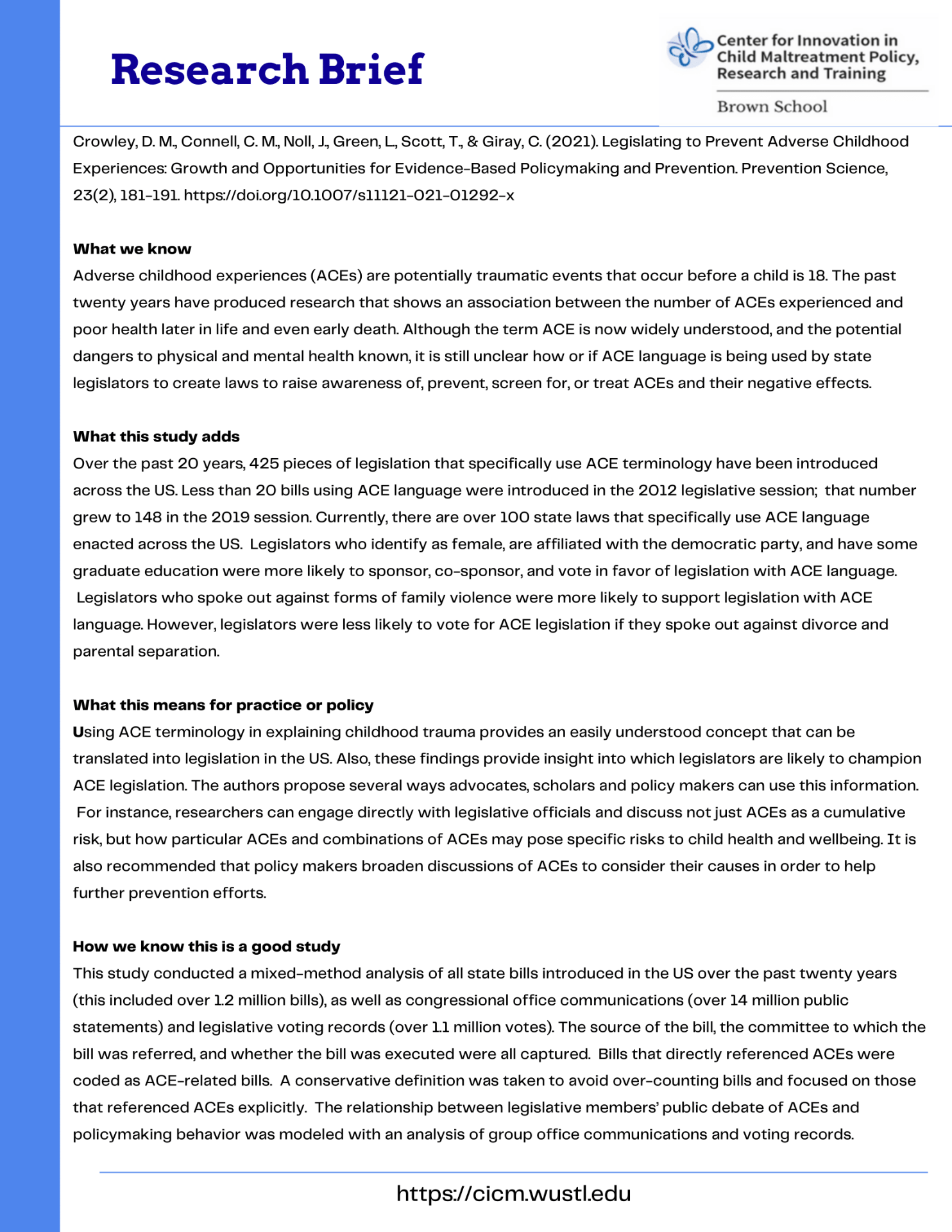Legislating to Prevent Adverse Childhood Experiences
Brief Review

Crowley, D. M., Connell, C. M., Noll, J., Green, L., Scott, T., & Giray, C. (2021). Legislating to Prevent Adverse Childhood Experiences: Growth and Opportunities for Evidence-Based Policymaking and Prevention. Prevention Science, 23(2), 181 191.
What we know
Adverse childhood experiences (ACEs) are potentially traumatic events that occur before a child reaches the age of 18. The past 20 years have produced research that shows an association between the number of ACEs experienced and poor health later in life and even early death. Although the term ACE is now widely understood, and the potential dangers to physical and mental health known, it is still unclear how or if ACE language is being used by state legislators to create laws to raise awareness of, prevent, screen for, or treat ACEs and their negative effects.
What this study adds
Over the past 20 years, 425 pieces of legislation that specifically use ACE terminology have been introduced across the United States. The last 10 years have seen the largest increase. While less than 20 bills using ACE language were introduced in the 2012 legislative session, that number grew to 148 bills introduced in the 2019 session. Currently, there are over 100 state laws that specifically use ACE language enacted across the US. Legislators who identify as female, are affiliated with the Democratic Party, and have some graduate education are more likely to sponsor, co-sponsor, and vote in favor of legislation with ACE language. Legislators who spoke out against forms of family violence – both maltreatment and domestic violence – were more likely to support legislation with ACE language. However, legislators were less likely to vote for ACE legislation if they spoke out against divorce and parental separation.
What does this mean for practice or policy?
This study shows that using ACE terminology in explaining childhood trauma provides an easily understood concept that can be translated into legislation and the political process in the US. Also, these findings provide insight into which legislators are likely to champion ACE legislation at different parts of the policymaking process. The authors propose several ways advocates, scholars, and policymakers can use this information. For instance, researchers should feel emboldened to engage directly with legislative officials and discuss not just ACEs as a cumulative risk, but how particular ACEs and combinations of ACEs may pose specific risks to child health and wellbeing. It is also recommended that policymakers broaden discussions of ACEs to consider causes–poverty, racism, and inequality–to help further prevention efforts. More explicit consideration of these structural factors as they contribute to ACE policy should be considered.
How do we know this is a good study
This study conducted a mixed-method analysis of all state bills introduced in the US over the past twenty years (this included over 1.2 million bills), as well as congressional office communications (over 14 million public statements) and legislative voting records (over 1.1 million votes). The source of the bill, the committee to which the bill was referred, and whether the bill was executed were all captured. Bills that directly referenced ACEs were coded as ACE-related bills. A conservative definition was taken to avoid over-counting bills and focused on those that referenced ACEs explicitly. Also, through analysis of group office communications and voting records, the relationship between legislative members’ public debate of ACEs and policymaking behavior was modeled.